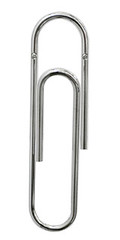A Guest Post from Robert Milton
On Monday, Dr. Michael Clair of Massachusetts was sentenced to one year in jail because he used paper clips instead of stainless-steel posts for root canals and then fraudulently billed Medicaid the full price. One of the patients involved in this particular case, Joshua Almeida, suffered toothaches and eventually lost his tooth from the botched root canal.
What can we take away from all this?
I think there are a number of lessons to be learned from the “Paper Clip Dentist” scandal, but two things in particular stuck out to me.
Safety Over Cutting Corners
The paper clip post and core method for root canals may be familiar to some dental students. It’s not unheard of for a root canal project in a third year Restoration course to use a paper clip for the temporary core of a provisional crown. Even one of the most frequently cited textbooks on the subject, Fundamentals of Fixed Prosthodontics by Herb Schillingburg, DDS, includes this less than optimal material where you would expect a stainless-steel post to be used. However, it’s important to note that it is considered only for temporary use.
Clair acknowledges he used the common office supply because it was cheaper than the $50 a piece stainless-steel posts. He might have gotten away with it for the temporaries, but he kept them in permanently leaving unaware patients with structurally unsound teeth and vulnerable to infection.
It’s no secret that running a dental practice is expensive. Of course you’ll want to look for a way to cut costs when you’re dealing with massive student loan debt from dental school, keeping equipment up-to-date, and the everyday business expenses of rent, utilities, and payroll. But safety should always trump cutting corners financially. Granted, Clair may be suffering from some sort of mental issue that impairs judgment, but I believe his extreme case serves as a reminder not to cross ethical boundaries when under financial stress.
Easing Dental Fear
An estimated 75% of Americans are fearful of the dentist with up to 10% of those avoiding dental appointments all together. Much of the anxiety associated with dental work is a result of previous bad experiences whether it was a painful procedure or a poor relationship with a dentist. However, news stories such as this most recent lawsuit can horrify patients indirectly.
There’s a good chance that you’ll be faced with even more challenging dental patients than before. After all, root canals are already one of the most feared procedures and now they’ll shutter every time they reach for a paper clip at work. It may be time to boost your chair side manner in regards to this heightened anxiety.
Communication is everything. Keep your ears open and the conversation going with each patient. Some may not want to know what’s happening at all, but many relax when a full explanation of the procedure is given. Perhaps now would be a good time to start showing them the materials you’ll be using so they know you don’t shop at Office Depot for dental supplies.
Providing quality care and squashing fears make for a successful dentist. If you win them over while they’re in your chair, they’ll return frequently and brag about you in between appointments. As a bonus, you’ll get to feel all warm and fuzzy inside.
Does anything else strike a chord with you about the Paper Clip Dentist case?
Robert Milton writes for Austin Dental Center, an Austin dentist that’s dedicated to making patients feel comfortable while providing a wide range of services from mercury-free fillings to dental implants. You can find them at 2304 Hancock Drive #1, Austin, TX 78756 or call (512) 454-0414.















